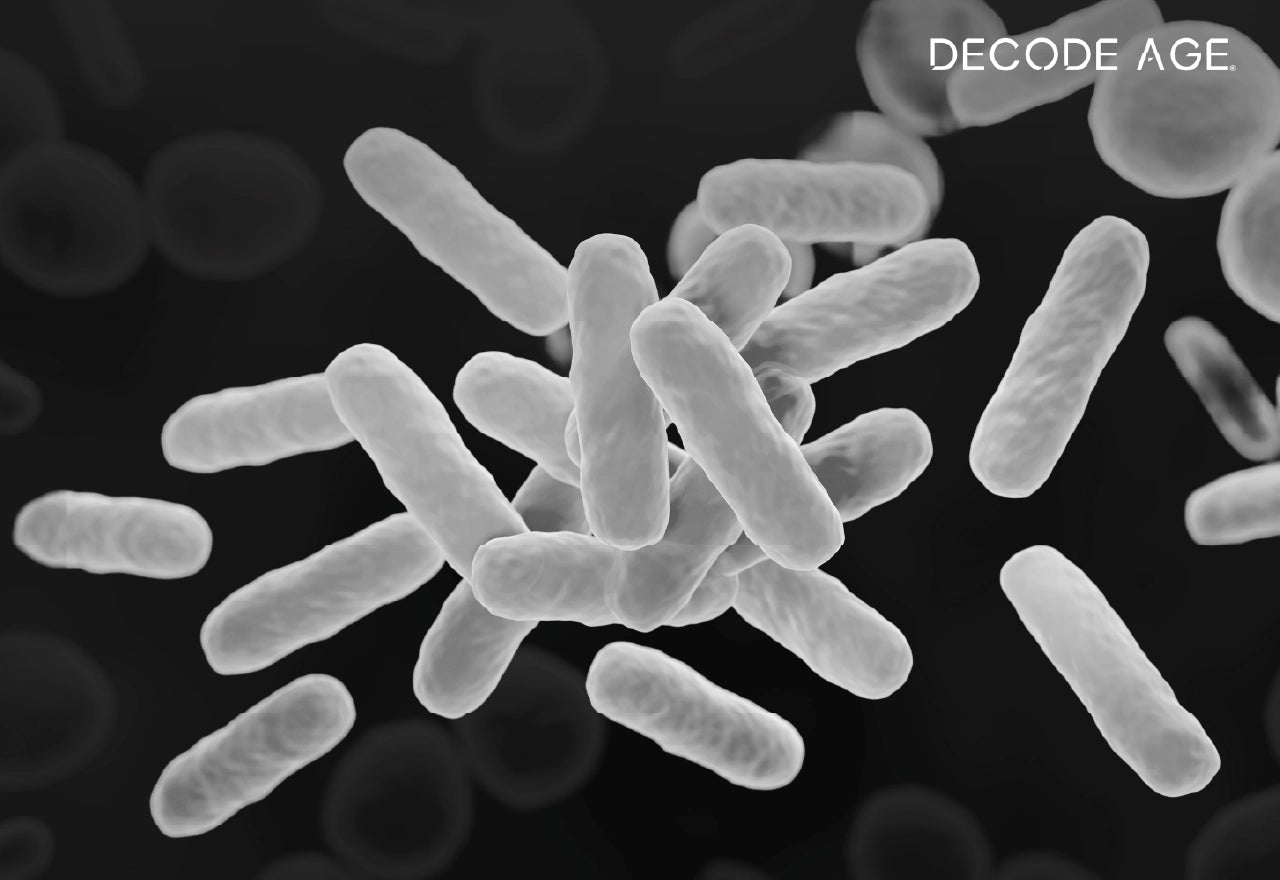Ageing is a complex process that involves progressive changes in physiological function and homeostasis. The gut microbiome, which is composed of trillions of microorganisms residing in the gastrointestinal tract, has emerged a key player in regulating various aspects of physiology and health. Studies suggest that the gut microbiome undergoes significant changes during ageing, with alterations in microbial composition, diversity and function. These deviations are thought to contribute to age-related diseases, such as type 2 diabetes, inflammatory bowel disease and frailty, and may also play a role in cognitive decline and neurodegeneration.
In this review, we will discuss the potential functions of the gut microbiome and how it is related with ageing and age-related diseases.
The ABCs of the Gut Microbiome
The human body is a host to a significantly greater quantity of microbial cells in comparison to human cells. The colonization of microorganisms on exposed surfaces such as the mouth, skin, gut and vagina begin immediately after birth. The collective genetic material of the microbiota, composed of bacteria, yeast, fungi and other microorganisms, forms the microbiome. The microbiota upholds a beneficial and mutualistic association with the human host and has a significant impact on the overall health and physiological functioning.
The gut microbiota is the most protuberant component of the human microbiota ecosystem and the composition of gut bacteria is influenced by several factors, including intestinal motility, pH, redox state, nutrition and the presence of an intact ileocecal valve. Extrinsic factors such as antibiotic usage, disease, ageing, poor dietary habits and lifestyle can also affect gut microbiota composition.
Dysbiosis, or an imbalance in the gut microbiota, has been associated with various diseases, including cancer, cardiovascular disease and inflammatory bowel disease. Microorganisms and their metabolites also play critical roles in energy metabolism, nutrient absorption, immune function and other vital physiological processes. Disruption of the commensal relationship between the host and microbiota can result in the development of various human diseases i.e., gastrointestinal diseases, autoimmune diseases etc. (1).
Understanding the intricate interplay between the gut microbiome and aging may pave the way for new therapeutic interventions to promote healthy ageing.
Major Microbial Groups Found in the Gut and their Relative Abundance
To investigate alterations in the healthy microbiota, it is imperative to have a comprehensive understanding of the microorganisms that normally inhabit the human gut. This knowledge is essential to establish a baseline for comparison and to identify changes that may lead to disease or other perturbations. Current estimates suggest that the gastrointestinal tract harbours a staggering count of microorganisms, including bacteria, viruses, fungi, and protozoa, that exceed human cell count by a factor of 100 trillion. Notably, 99% of the bacteria of entire gut microbes are anaerobes. The inner environment of the gut has low oxygen levels which favours the expansion of strict anaerobic bacterial species. Conversely, the cecum has high densities of aerobic bacteria, which thrive in an oxygen-rich environment (2).
The gut microbiome is dominated by six major phyla of microorganisms, namely Firmicutes (e.g., Ruminococcus, Clostridium, Lactobacillus, Faecalibacterium, Streptococcus species), Bacteroidetes (e.g., Bacteroides, Xylanibacte, Prevotella), Proteobacteria (e.g., Desulfovibrio, Escherichia), Actinobacteria (e.g., Bifidobacterium, Collinsella), Euryarchaeota (e.g., Methanobrevibacter) and Verrucomicrobia (e.g., Akkermansia) (Fig.1). These phyla exhibit a vast diversity of microbial species that interact with the host in intricate ways, influencing various physiological processes such as digestion, metabolism, and immune function (3,4).

Fig.1. Six major phyla of human gut microbiota and their predominant species (4).
The survival rate of microorganisms in the stomach is exceptionally low due to the highly acidic environment. Gram-positive cocci and rod-shaped bacteria are principally present in the small intestine, while the alkaline environment of the distal part of the small intestine promotes the growth of Enterobacteriaceae. The dominant phyla of the intestinal microbiota are Bacteroidetes, Firmicutes, Actinobacteria, Proteobacteria and Verrucomicrobia. Bacteroidetes and Firmicutes alone account for 90% of the entire population, with other genera such as Escherichia, Veillonella, Bacteroides, Clostridium, Lactobacillus and Streptococcus also found in the intestinal tract. Due to a significant reduction in enzyme activity, the colon harbors vast microbial diversity, including Acidaminococcus, Faecalibacterium, Veillonella, Pseudomonas, Enterobacter, Escherichia, Eubacterium, Fusobacterium, Klebsiella, Lactobacillus, Megasphaera, Salmonella, Peptostreptococcus, Peptococcus, Proteus, Ruminococcus and Clostridium species, with different species present in varying numbers (5) (Fig.2).

Fig.2. Dominant species in different parts of the gastrointestinal tract (4).
When the transverse section of the intestine was studied, it was observed that there exists a variation in the composition of microbiota across the intestinal wall. For instance, genera such as Bifidobacterium, Bacteroides, Streptococcus, Clostridium and Ruminococcus were found in the luminal population, whereas the epithelial crypts and mucus layer of the small intestine were found to contain only Enterococcus, Clostridium and Lactobacillus. These findings suggest that the distribution of bacterial populations in the gut is not uniform and varies depending on the location within the gut. Furthermore, the location-specific distribution of microbiota may have functional implications in the gut, such as nutrient uptake and immune modulation (6).
Functions of Gut Microbiota
Digestion
Humans are not able to digest all kinds of carbohydrates i.e., oligosaccharides, starches and sugars like lactose. Bacteria that are present in the large intestine have the capability to convert carbohydrates into short chain fatty acids (SCFAs). The conversion process releases products like propionic, acetic and butyric acid. Propionate acts as a satiety molecule and facilitates the production of ATP in the liver. On the other hand, butyrate induces the process of apoptosis in malignant epithelial cells that line the large intestine, this provides energy to gut cells and lowers the risk of bowel cancer. Acetic acid is used by muscles (7).
Metabolism
Gut bacteria can generate a range of critical vitamins for survival and health, as well as synthesize all essential and nonessential amino acids and perform bile biotransformation. Water- soluble vitamins like thiamine (B1), riboflavin (B2), nicotinic acid (B3), pantothenic acid (B5), biotin (B7), folic acid (B9), cobalamin (B12) and fat-soluble vitamins, i.e., Vitamin K, can be produced by a microbial community rich in Lactobacilli, Bifidobacterium, and E. coli. It also helps in nutrient absorption such as magnesium, iron and calcium (8).
Direct inhibition of pathogens
Gut microbiota protects the body against infections through a barrier or competitive-exclusion effect. Additionally, Microflora generates bacteriocins to inhibit the growth of their competitors (4).
Immune-system development
Gut bacteria are able to ferment food components and generate SCFA which induce rapid increase in the production of basophils, eosinophils and neutrophils (9). Specific receptors are present on the intestinal epithelium. These receptors recognize and bind to specific bacteria-associated chemicals, causing the release of protective peptides, cytokines and white blood cells as a result of the host immune response. Among gut bacteria Clostridia species and Bacteroides fragilis have been found to cause an anti-inflammatory response, while some segmented filamentous bacteria have been found to cause inflammatory cytokine production. Gut microflora also helps to regulate the production of antibodies which further initiates B cells conversion to IgA cells. IgA is an important antibody for the mucosal gut environment. IgA helps in creating diversity in gut microflora and helps to get rid of inflammation causing bacteria thus, maintains a healthy gut environment (10).
The gut–brain axis
“Gut–Brain axis” broadly includes the neuroendocrine, central nervous system and neuroimmune systems including the hypothalamic–pituitary–adrenal axis (HPA axis), sympathetic and parasympathetic arms of the autonomic nervous system including the enteric nervous system, vagus nerve and the gut microbiota (10).
Studies have suggested that communication between the central nervous system and gut bacteria influences the host’s stress reactivity. Studies have also shown that probiotic strains have potential to treat the central nervous system disorders. Probiotics which have shown improvement in neural disorders contain bacteria of Lactobacillus and Bifidobacterium genera. Obligate anaerobic bacterial population like Fusobacterium, Bacteroides, Clostridium etc. of gut are responsible for digesting complex dietary fibres into metabolites, which are then absorbed by the host cells for different immunological purposes (11).
Gut Microbiome and Age-related Metabolic Diseases
With an ageing population worldwide, the occurrence of metabolic diseases has also drastically increased. Alteration in gut microbiome and microbial metabolites is known to be associated with deviations of gut barrier integrity and boosted proinflammatory cytokines; and all these elements can partly or potentially underlie the pathogenesis and progression of various metabolic diseases that are predominant in old people such as insulin resistance, adiposity, cardiovascular diseases, fatty liver and hepatic steatosis, atherosclerosis diminished motor activity (12). Dysbiosis can also impact gut-brain axis thereby hampering endocrine, neural, nutrient and immunological signals between gut and brain via enteric nervous system (ENS) and could play a role in development of diseases related to central nervous system (CNS) such as autism, multiple sclerosis, depression and anxiety (13).
Cancer
Nearly 20% of all cancer cases in the world are thought to be linked with gut microbiota. It was reported that Fusobacterium nucleatum subdues host immune response and triggers cellular proliferation. Butyrate is an important SCFA for healthy colon and genera which produce were almost absent in colorectal cancer (CRC) patient’s stool whereas, bacteria like Phascolarctobacterium, Acidaminobacter and Citrobacter were present in significant number in CRC patient’s stool samples (14). Helicobacter pylori is related to the major risk of stomach cancer in humans. New research suggested that elevated population of bacterial spp. like Fusobacterium and Clostridium can be observed in stomach cancer patients. In case of cancer, there is a disturbance in intestinal barrier and bacteria from intestinal lumen reaches in the tissue which initiates many inflammatory responses. One of them is induction of pattern recognition receptors which are linked to cancer progression. These receptors include mainly membrane bound TLRs (Toll-like receptors) and NLRs (Nod-like receptors) (15).
Liver disease
Beneficial substances produced by the liver are absorbed by the gut. Intestinal microflora produces ethanol, ammonia and acetaldehyde; the liver metabolizes these products and controls cytokine production and Kupffer cell activity. Studies have demonstrated that intestinal bacteria that produce hydrogen, have capability to reduce Concanavalin A-induced inflammation (16).
Diabetes
Diabetes is a metabolic disease which is strongly related to the gut microbiome. There are 2 types of diabetes type-1 diabetes (T1D) and type-2 (T2D) are major concerns of the world. Studies showed that children with T1D have increased abundance of Veillonella, Clostridium, and Bacteroides whereas decreased abundance of Lactobacillus, Eubacterium rectale, Blautia coccoides, and Bifidobacterium group. Lactobacillus genus was in lower abundance in T2D patients and Bifidobacterium was in higher abundance (17). Alteration in gut microbiota directly affects the liver vascular barrier causing permeability to bacteria and other derived metabolites which triggers the immune system to generate inflammation. This affects the insulin tolerance factor inducing diabetes mellitus (18).
Cardiovascular diseases
Cardiovascular illnesses include heart failure, atherosclerosis (acute coronary syndrome and stroke) and hypertension. Atherosclerotic cardiovascular disease is characterized by high presence of Enterobacteriaceae and Streptococcus spp. in gut microbiome. In atherosclerotic plaques phylum Proteobacteria (Chryseomonas and Helicobacter genera) and phylum Firmicutes (Anaeroglobus, Clostridium, Eubacterium, Lactobacillales, and Roseburia genera) is found in abundance in gut cavity. Other bacterial species like Enterobacteriaceae, Streptococcus spp, Lactobacillales, and Collinsella population are altered in the gut among cardiovascular patients (19).
There are enough studies to show that dysbiosis of the gut microbiota causes a wide range of diseases, including cardiovascular disease, gastrointestinal problems, allergies, obesity, and CNS-related diseases (Table 1).
Table.1. Gut dysbiosis chart for different diseases.
|
Disease |
Bacteria that decreases in number |
Bacteria that increases in number |
References |
|
Colon Cancer |
Faecalibacterumi prausnitzii |
Akkermansia muciniphila |
20,21 |
|
Colorectal cancer |
Prevotella, Ruminococcus spp., Pseudobutyrivibrio ruminis |
Acidaminobacter, Phascolarctobacterium, Citrobacter farmer |
20,21 |
|
Gastric cancer |
Eubacterium rectalie |
Clostridium, Fusobacterium |
20,21 |
|
Obesity |
Bacteridetes, Methanobrevibacter smithii |
Enterobacteria, Ruminococcus gnavus |
22 |
|
Diabetes Type 1 |
Lactobacillus,Bifidobacterium, Blautia coccoides, Eubacterium rectal, Prevotella |
Clostridium, Bacteroides, Veillonella |
23 |
|
Diabetes type 2 |
Firmicutes, Clostridia, Lactobacillus, Eubacterium rectale, |
Betaproteo bacteria, Bacteroidetes/Firmicutes ratio increased |
24 |
|
Liver disease |
Alistipes, Bilophila, Veillonella, Faecalibacterium, Ruminococcus, Bifidobacterium, Coprococcus, Prevotella copri, Faecalibacterium, Haemophilus |
Bacteroidetes, Betaproteobacteria, Lactobacillus spp., Collinsella, Corynebacterium, Prevotellaceae, Ruminococcaceae, Sutterellaceae, Enterobacteriaceae, Bacteroidaceae |
25 |
|
Autism |
Firmicutes, Actinobacteria, Actinobacteria |
Bacteroides vulgates, Desulfovibrio, Proteobacteia |
26 |
Microbiome Derived Metabolites in Ageing
Short chain fatty acids (SCFAs) such as propionate, butyrate and acetate are known to have significant beneficial effects on various aspects of metabolic and physiological health, including regulating gut pH, promoting growth of beneficial bacteria, supporting gut barrier integrity, and shaping peripheral metabolism. Among these, butyrate is particularly important as an energy source for colonic epithelium and has been shown to have a protective role against colorectal cancer (27). Propionate is important for liver gluconeogenesis and regulation of cholesterol synthesis, while acetate supports liver lipogenesis and regulation of colonic blood flow (28).
However, during ageing, the levels of SCFAs in the intestinal metabolic environment can decline due to changes in diet, drug exposure and gut microbiome composition. This decline in SCFA levels may increase susceptibility to inflammatory diseases such as Crohn’s disease and IBD, as well as affect host immune and inflammatory health. Reduced levels of butyrate, in particular, have been associated with a number of inflammatory intestinal diseases and can impact insulin sensitivity and energy expenditure by affecting mitochondrial activity (29).
Additionally, lower levels of propionate may affect intestinal gluconeogenesis (30) and gut-brain neural circuit, while decline in SCFA-producing bacteria could modulate neuro-immune activation and underlie higher incidence of gastrointestinal perturbations linked with neurodegenerative diseases, such as diarrhea, constipation, obesity, and diabetes (31).
Therefore, it is important to maintain adequate levels of SCFAs, especially butyrate, in the aging population to promote optimal gut health and mitigate the risk of inflammatory diseases and other related health issues. Strategies to achieve this may include increasing dietary fiber intake, limiting the use of antibiotics, and a healthy lifestyle.
Conclusion
Gut microbiome is a complex ecosystem that plays a crucial role in maintaining human health and well-being. As people age, changes in the gut microbiome can contribute to inflammation, metabolic dysfunction and a weakened immune system. These changes have been linked to various age-related conditions such as cardiovascular disease, Alzheimer's disease and cancer.
Studies have also demonstrated that diet, exercise and certain medications can impact the gut microbiome and potentially reduce the risk of age-related diseases. For example, a diet rich in fiber and fermented foods can promote the growth of beneficial gut bacteria, while antibiotics can disrupt the balance of the microbiome and increase the risk of certain diseases (4). By understanding the mechanisms underlying the relationship between the gut microbiome and aging could provide new therapeutic strategies to prevent or delay age-related disorders. Therefore, further research is needed to unravel the complex interplay between the gut microbiome, ageing and age-related diseases, with the ultimate goal of promoting healthy ageing and improving the quality of life of elderly individuals.


























Leave a comment
All comments are moderated before being published.
This site is protected by hCaptcha and the hCaptcha Privacy Policy and Terms of Service apply.